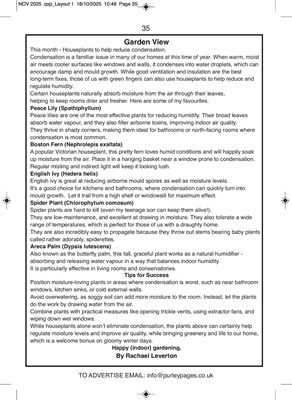
35
TO ADVERTISE EMAIL: info@purleypages.co.uk
Garden View
This month - Houseplants to help reduce condensation.
Condensation is a familiar issue in many of our homes at this time of year. When warm, moist
air meets cooler surfaces like windows and walls, it condenses into water droplets, which can
encourage damp and mould growth. While good ventilation and insulation are the best
long-term fixes, those of us with green fingers can also use houseplants to help reduce and
regulate humidity.
Certain houseplants naturally absorb moisture from the air through their leaves,
helping to keep rooms drier and fresher. Here are some of my favourites.
Peace Lily (Spathiphyllum)
Peace lilies are one of the most effective plants for reducing humidity. Their broad leaves
absorb water vapour, and they also filter airborne toxins, improving indoor air quality.
They thrive in shady corners, making them ideal for bathrooms or north-facing rooms where
condensation is most common.
Boston Fern (Nephrolepis exaltata)
A popular Victorian houseplant, this pretty fern loves humid conditions and will happily soak
up moisture from the air. Place it in a hanging basket near a window prone to condensation.
Regular misting and indirect light will keep it looking lush.
English Ivy (Hedera helix)
English ivy is great at reducing airborne mould spores as well as moisture levels.
It's a good choice for kitchens and bathrooms, where condensation can quickly turn into
mould growth. Let it trail from a high shelf or windowsill for maximum effect.
Spider Plant (Chlorophytum comosum)
Spider plants are hard to kill (even my teenage son can keep them alive!).
They are low-maintenance, and excellent at drawing in moisture. They also tolerate a wide
range of temperatures, which is perfect for those of us with a draughty home.
They are also incredibly easy to propagate because they throw out stems bearing baby plants
called rather adorably, spiderettes.
Areca Palm (Dypsis lutescens)
Also known as the butterfly palm, this tall, graceful plant works as a natural humidifier -
absorbing and releasing water vapour in a way that balances indoor humidity.
It is particularly effective in living rooms and conservatories.
Tips for Success
Position moisture-loving plants in areas where condensation is worst, such as near bathroom
windows, kitchen sinks, or cold external walls.
Avoid overwatering, as soggy soil can add more moisture to the room. Instead, let the plants
do the work by drawing water from the air.
Combine plants with practical measures like opening trickle vents, using extractor fans, and
wiping down wet windows.
While houseplants alone won't eliminate condensation, the plants above can certainly help
regulate moisture levels and improve air quality, while bringing greenery and life to our home,
which is a welcome bonus on gloomy winter days.
Happy (indoor) gardening,
By Rachael Leverton
NOV 2025 .qxp_Layout 1 18/10/2025 10:48 Page 35